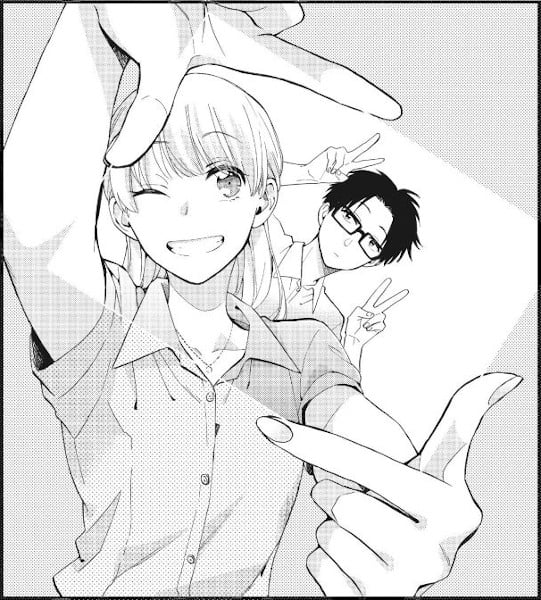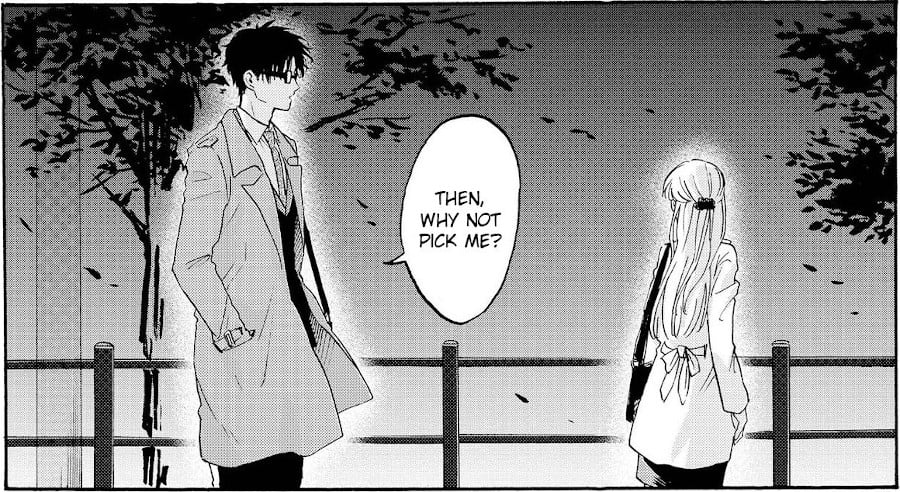Wait, didn’t we do this a fortnight ago?
Yes.
Yes we did.
Because this series is that good.
See, I saw the opening to Wotakoi on Youtube. I went: Oh that’s really cute and the premise is fun. I should check this out. And then we cough watched the anime. I was smitten with it, I found it exciting and interesting, and started quoting things from it back and forth with Fox, and eventually got to the point where I was sharing bits of it with friends on Discord and eventually calling Hirotaka the one good gamer boy. I may have even tried a t-shirt design. Do you know how rare it is for me to shell out for volumes of manga? The last one I got was Monster, and before that? Ranma 1/2.
This is a really good manga.

In case you missed it (why), Wotakoi: Love Is Hard For Otaku is a 2014 pixiv webcomic that became a published manga and then it got a movie and an anime. It follows the day to day life of Narumi Momose, an office lady and turbo-nerd who finds her elementary school friend Nijifu Hirotaka is working at her new job. Which she started because she just had a big breakup and an upsetting life change because her last boyfriend dumped her for being, specifically, a fujoshi. That is, she likes media about hot boys fuckin’.
This is obviously a massive dealbreaker for whatever boring knucklehead she was dating, and she bemoans her plight to her old friend. An otaku friend, though, is a rare thing, and a joy to have — so she says. But Hirotaka asks her — why not me? I wouldn’t make you cry. I wouldn’t make you feel bad for what you love.
And he offers to crew her booth at the next Comiket.
This overwhelming demonstration of true otaku love transpires, and she agrees to it and what begins is an awkward relationship of a boy who doesn’t express himself very well, but loves someone very much, and a girl who is full of anxieties about the way society treats her for loving what she loves. The story expands to include their workplace senpais, Koyanagi (a voluptuous accountant cosplayer) and Kabakura (a fiery team-captain type who wants to keep his Otakuness on the downlow), and Hirotaka’s little brother and a girl he meets with overwhelming social anxiety. It’s great, it’s funny, it’s charming, and every one of the characters is obviously the best one. You were here, you saw the last time I talked about this.
Why is the Manga its own thing?

I think part of why I’m talking about this manga is because — well okay, first of all it’s really good. It’s really stunningly good, it uses a lot of different visual motifs to make the series pop. There’s changes in art style, there are different ways to depict people that communicate different emotional states, there’s font jokes for heck’s sake. Being a manga, and being both longer and more inclined towards the inner lives and moments of the characters, though, we get to dwell more on different things – on how the characters think about things, not just what they do about things in time-sensitive ways.
A detail the anime touches on but doesn’t put into focus in the same way as the manga is how much Narumi and Hanako are makers. The boys — Hirotaka and Kabakura — both are asked about their interest in making things, but they recognise that just because they enjoy reading manga or playing games, they don’t actually want to make things. They have ideas about how they want the media to go or the way they want the games to work, but they also show a strangely wholesome idea about how they handle that: They just stop. We don’t get Kabakura tweeting death threats at a mangaka for killing off his waifu, even when that happens. He gets upset and sad, and that’s it.
There’s an honesty to it. Hirotaka is asked if he’d like to have make games, growing up — and he flat out says that just because he likes playing them, doesn’t know he knows how to make them. He doesn’t know how to make games good — he just knows what he enjoys, what he wants to do when in them. It’s a beautiful thing — he’s a game player who doesn’t feel that his playing entitles him to expertise in the other elements of it. There’s a reason I say Hirotaka is the only good gamer boy.
A hobby is something you love to do. Is there any point to this if you’re just suffering?
Koyanagi
Koyanagi and Narumi, however, don’t just partake in fandom through their consumption. They make things. They are creators. In (the English) third volume, there’s a section about Koyanagi getting a cosplay together for Narumi. If you want an interesting kind of insight into the scope and challenge of that, mind you, they do touch on some details, they do show some of the details people often don’t consider about the complexities of constructing a characterisation, visually, with real world materials. It’s a real testament to the thoughtfulness and excellence of the whole experience. You don’t know these things unless you ask the people who do them.
Narumi in turn, is grappling with the storyboard for her latest dirty doujinshi. Koyanagi praises them, and Narumi objects — because she thinks she can do better. Note: Narumi is objecting to praise of her own work. Koyanagi insists the work is good, and this isn’t false modesty. Narumi is struggling with her work, and Koyanagi thinks what she’s made is good enough… and Narumi disagrees.
They talk about it; across several days, in fact. There’s no snappy exchange. Just two quotes that stand out. The first, above: A hobby is something you love to do. Is there any point to this if you’re suffering?
The response is excellent:
It’s because this is a hobby I love. I have to take it seriously. It’s no fun if I compromise.
Narumi
Narumi is playing. Making the doujin is a goal, yes, but it isn’t just making the doujin, it isn’t just about the consequences of success or failure. The doujin is the product, but she wants it to be difficult. She wants to do a better job. It isn’t just about making a doujin — it’s about making a better doujin than she had made. It’s about using the new ideas, it’s about how just after one Comiket she’s already drafting ideas for the next Comiket’s issue.
It’s the feeling I get when I’m done with a convention, full of ideas I had at the convention, on the floor, thinking about priorities of what I can do next. What will work when I can playtest it. What’s not going to be good enough.
What I want to do next.
What I don’t want to compromise.
I say, from time to time, that play is a creative act. What I think gets lost in the exchange is that creative acts can also be seen as play — and how serious a thing I think that is. It isn’t a diminishment of play to say that creative acts are playful and playful acts are creative. It’s entirely possible for play and art and creation to all come together, and I would never imply that play, being play, is unimportant. Play is not frivolous. Play can be as serious as a heart attack.
Wotakoi is a series so nice I wrote about it twice. It’s an absolutely excellent series and I love the characters. And even if I didn’t, I think this exchange deserves attention.
1 Trackback